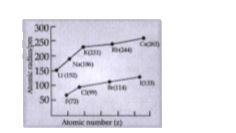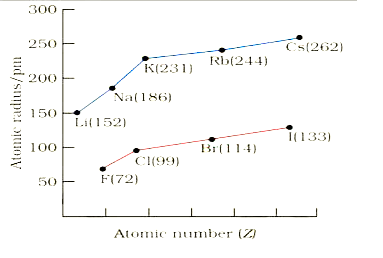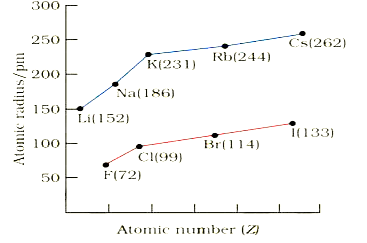Alkali metals have very small value of electronegativity. The electronegativity down the group
increases
decreases
remains same
none of these.
The correct Answer is:B
The size increases and therefore the electronegativity decreases.
Topper's Solved these Questions
- BOOK - DINESH PUBLICATIONCHAPTER - THE ALKALI METALSEXERCISE - RQ172videos
THE ALKALI METALS
- BOOK - DINESH PUBLICATIONCHAPTER - THE ALKALI METALSEXERCISE - Reason Assertion15videos
THE ALKALI METALS
- BOOK - DINESH PUBLICATIONCHAPTER - SURFACE CHEMISTRYEXERCISE - Ultimate Prepatarory Package16videos
SURFACE CHEMISTRY
- BOOK - DINESH PUBLICATIONCHAPTER - THE BORON FAMILY EXERCISE - Ultimate Preparatory Package13videos
THE BORON FAMILY
Similar Questions
Read the following and answer the question
Metallic Character:
The ability of an atom to donate electrons and form positive ion (cation) is known as electro-positivity or metallic character. Down the group, metallic character increases due to increase in atomic size and across the period, from left to right electro-positivity decreases due to decrease in atomic size
Non-Metallic Character:
The ability of an atom to accept electrons to form a negative ion (anion) is called non-metallic character or electronegativity. The elements having high electro-negativity have a higher tendency to gain electrons and form anion.
Down the group, electronegativity decreases due to increase in atomic size and across the period, from left to right electro-negativity increases due to decrease in atomic size.

Which of the following correctly represents the decreasing order of metallic character of Alkali metals plotted in the graph ?View SolutionMetals have few electrons in their valence shell while non-metals generally have more electrons in their valence shell. Metallic character is closely related to atomic radius and ionisation enthalpy. Metallic character increases from top to bottom in a group and decreases from let to right in a period of periodic table. metallic character is inversely related to electronegativity of element.
Q. The electronegativity of the following elements increase in the order:View Solution
Knowledge Check
- Question 1 - Select One
Metals have few electrons in their valence shell while non-metals generally have more electrons in their valence shell. Metallic character is closely related to atomic radius and ionisation enthalpy. Metallic character increases from top to bottom in a group and decreases from let to right in a period of periodic table. metallic character is inversely related to electronegativity of element.
Q. The electronegativity of the following elements increase in the order:AC,N, Si, PBN, Si, C, PCSi, P, C, NDP, Si, N, C - Question 2 - Select One
Correct order of electronegativity of group 15
AN>P>As>SbBSb>As>P>NCN>As>P>SbDN>As>Sb>P - Question 3 - Select One
Alkali metals are in a group-
AIIABVIIACIADIII A
Which of the following have similar values of electronegativity?
View SolutionMetallic Character
The ability of an atom to donate electrons and form positive ion (cation) is known as electropositivity or metallic character. Down the group, metallic character increases due to increase in atomic size and across the period, from left to right electropositivity decreases due to decrease in atomic size.
Non-Metallic Character
The ability of an atom to accept electrons to form a negative ion (anion) is called non-metallic character or electronegativity. The elements having high electro-negativity have a higher tendency to gain electrons and form anion. Down the group, electronegativity decreases due to increase in atomic size and across the period, from left to right electronegativity increases due to decrease in atomic size

Which of the following correctly represents the decreasing order of metallic character of Alkali metals plotted in the graph?View SolutionMetallic Character
The ability of an atom to donate electrons and form positive ion (cation) is known as electropositivity or metallic character. Down the group, metallic character increases due to increase in atomic size and across the period, from left to right electropositivity decreases due to decrease in atomic size.
Non-Metallic Character
The ability of an atom to accept electrons to form a negative ion (anion) is called non-metallic character or electronegativity. The elements having high electro-negativity have a higher tendency to gain electrons and form anion.Down the group, electronegativity decreases due to increase in atomic size and across the period, from left to right electronegativity increases due to decrease in atomic size

Hydrogen is placed along with Alkali metals in the modern periodic table though it shows non-metallic characterView SolutionMetallic Character
The ability of an atom to donate electrons and form positive ion (cation) is known as electropositivity or metallic character. Down the group, metallic character increases due to increase in atomic size and across the period, from left to right electropositivity decreases due to decrease in atomic size.
Non-Metallic Character
The ability of an atom to accept electrons to form a negative ion (anion) is called non-metallic character or electronegativity. The elements having high electro-negativity have a higher tendency to gain electrons and form anion. Down the group, electronegativity decreases due to increase in atomic size and across the period, from left to right electronegativity increases due to decrease in atomic size

Which of the following has highest electronegativity?View SolutionMetallic Character
The ability of an atom to donate electrons and form positive ion (cation) is known as electropositivity or metallic character. Down the group, metallic character increases due to increase in atomic size and across the period, from left to right electropositivity decreases due to decrease in atomic size.
Non-Metallic Character
The ability of an atom to accept electrons to form a negative ion (anion) is called non-metallic character or electronegativity. The elements having high electro-negativity have a higher tendency to gain electrons and form anion. Down the group, electronegativity decreases due to increase in atomic size and across the period, from left to right electronegativity increases due to decrease in atomic size

Which of the following reason correctly justifies that “Fluorine (72pm) has smaller atomic radius than Lithium (152pm)”?View Solution

